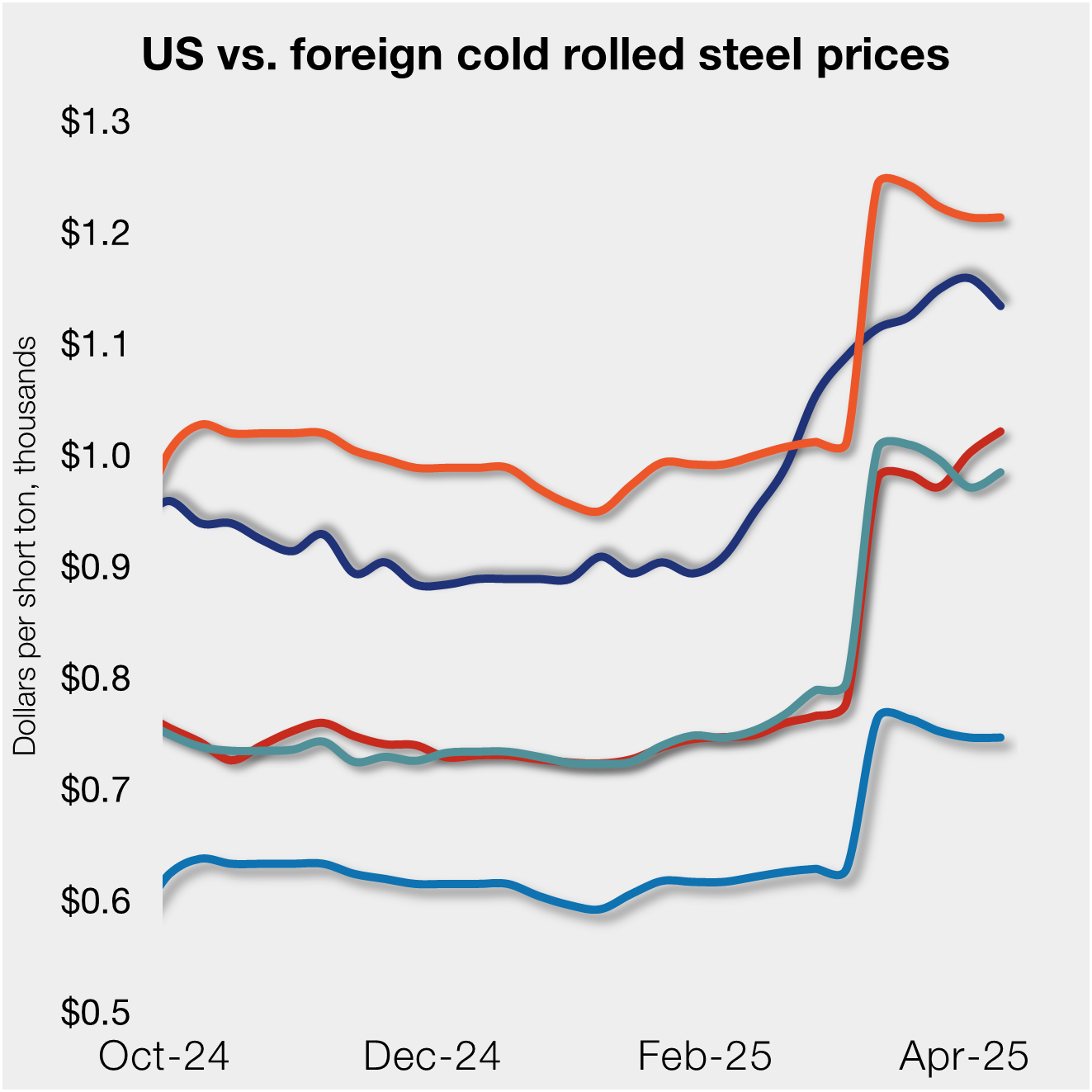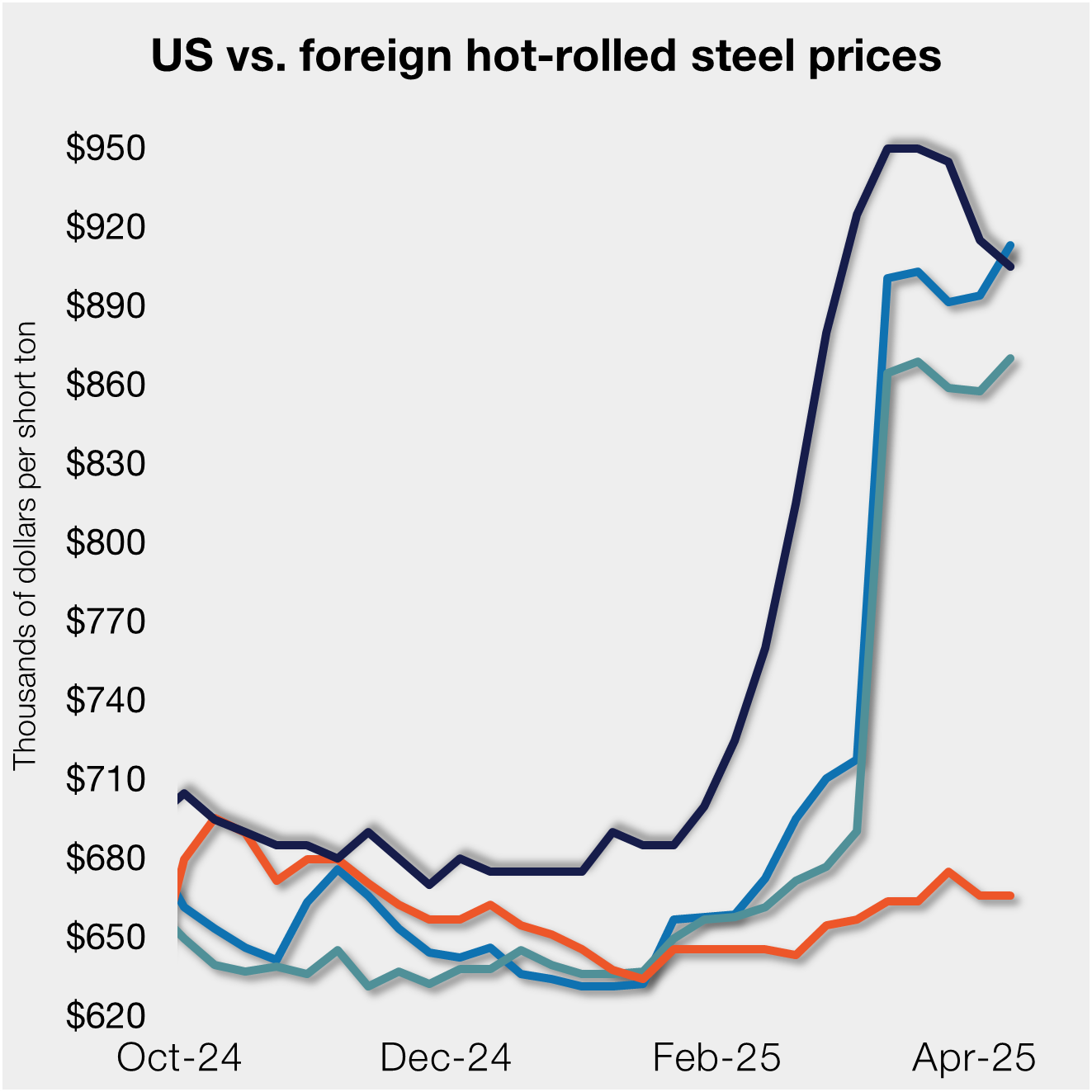Steel Products

Trump Non-Announcement Announcement Spooks Stock Market & Steel Buyers
Written by John Packard
March 1, 2018
The White House announced that it would be formally announcing the remedies under Section 232 on steel and aluminum this morning. Then they said no, there would not be an announcement this week. Shortly after that information was shared by the White House, President Trump was asked a question…
SMU advice to steel buyers: Do not panic. Do not over-read or believe the hype that is going to be associated with President Trump’s words of earlier today when he told reporters that foreign steel will be hit with a 25 percent duty and aluminum with a 10 percent duty. The words came with no details and the devil is in the details.
The CEO of a large steel service center told us late this afternoon, “We have all been extrapolating potential impacts around unknown variables for so long that we need to digest the news and wait for more clarity between now and next week.”
He went on to warn the steel industry of the unintended consequences related to actions like this. “Longer term the concern has to be downstream and how industrial metal consumers are going to react and plan as we have experienced a hollowing out of downstream manufacturing since 2000, and it will feel very pyhrric at best if at the end of this the unintended consequences were less customers. This has to be just one part of a much larger and longer game to make the U.S. the place of choice to manufacture on a level playing field.”
Near term, the responses we received were almost universal as steel buyers expect prices to move higher from here and the thought of $850 per ton or even $1,000 per ton hot rolled is not out of the question.
Less transparent is what is happening to supply. We have had steel buyers tell us that their mill suppliers are either not quoting “spot” tons or are on allocation. Steel Market Update did manage to speak to a few domestic mills today and were told that contracts were being honored (even at the high end of the ordering limits), regular customers were being serviced and new spot business was being considered. “I have steel to sell, but that will be going up with the market,” is what one commercial manager told SMU. Another mill told SMU that they are not seeing any panic in the same way that they did during the shortages of 2004 and 2008.
We were not able to speak to those mills whose source of supply is foreign slabs or hot band. We assume their situation is in a state of flux as they need to wait to see if their suppliers or products are exempt from any across-the-board tariff.
{loadposition reserved_message}
President Trump Tells Reporters Steel Tariff to be 25%
After almost one full year of waiting, President Trump today answered a question about tariffs on steel by saying there would be a 25 percent tariff on foreign steel and 10 percent tariff on aluminum. There were absolutely no details provided and we do not yet know if there are products or countries that will be exempt from this global tariff option that the president has selected.
The stock market closed lower by 420 points, which was an improvement from where the index was after the president’s comments were first made. There is now a worry in the financial markets as to how this move will impact interest rates (inflation) and if other countries will respond with new tariffs of their own on U.S. products (trade war). Canada and many other countries have suggested they will not allow steel or aluminum tariffs to go unchallenged.
A service center expressed his concern for the lack of details: “Trump’s comments are not surprising and unclear as to all the W’s, which matter [what, where, when, why…]. But expect prices to rise both due to the standard mill playbook as well as due to the uncertainty this will cause (risk requires price protection), let alone the stress it adds to the supply chain. Who knows to what extent and what velocity things could change in either direction and if or when repercussions may result. So, for those under contract – beware, who knows where the indices will go in the next 13 days! And yes, I fully expect $850….”
We found the comments we received from the general manager of a large service center helpful in trying to understand where the industry is today: “Well, the only good news is we have Trump’s initial decision in hand, and apparently only one week until the final decision(s) are made public. To the extent that we don’t have to stay in limbo until April 11, I see as a positive. The balance of course is negative, and one has to hope that this announcement was done in order to “shake up” the market prior to finalizing a less onerous outcome. I expect prices to continue to soar until the market can get a grasp of the size and scope of the outcomes.”
This service center then discussed the position of foreign steel in the United States. “Assuming a broad-based single tariff approach, with few if any exceptions, is almost hard to comprehend as being practical. We’ve been a country whose steel consumption has been based on roughly a 20 percent import level for decades. To attempt to alter that scenario to basically zero, in an immediate fashion via a 25 percent tariff, opens up endless opportunities for highly negative outcomes. Where is the talk of quotas? Where is the talk of targeting “cheaters”? Where is the recognition that Mexico and Canada are heavily intertwined with the U.S. steel production and consumption via NAFTA, and thus carved out?
“The range of imports, from common grades and sizes, to a sizable amount that is not even made in the USA, is quite vast. It’s almost as if the task of culling through the import spectrum was too much work, and thus hit everyone.
“Then there’s the issue of re-rollers here, who’ve relied for decades on imported slabs to produce coils. Think of UPI and CSI in California, where state-mandated environmental restrictions make melting steel prohibitive for all practical purposes (ask Nucor who has examined this in full). Thus the reliance on re-rolling was required, and based on their coastal locations, only imported slabs made economic sense.”
“The issue of an across-the-board tariff does not address the issue of oversupply in China and elsewhere. More importantly, the tariff does not penalize any foreign country. Just the opposite. The penalty is going to be born solely by the U.S. consumer. Another very good point brought up by a mill today was that the 25 percent duty does NO HARM to the exporting country, only to the U.S. consumer, so what was really achieved here?” asked a service center steel buyer.
Another service center told us, “The truly unfortunate part of all of this is the fact that there’s widespread agreement across the U.S. metal complex that our country should punish and/or prevent the importing of illegally imported/dumped material. The U.S. domestic mills have successfully litigated dozens and dozens of cases through the proper channels as set up in the WTO. To deviate wildly from this approach, and use national defense no less, is reckless in the least.”
SMU asked a trading company executive what this would mean to new hot rolled offers. He told us hot rolled would move to $45.00/cwt ($900 per ton base), cold rolled $50.00/cwt ($1,000 per ton base) and coated to $52.00/cwt ($1,040 per ton base).
Another trading company told us that .012 galvanized used in furnace pipe applications would go to the mid-$60s by mid-summer.
Many steel buyers told us they will continue to buy foreign steel and pay the tariff, or in some cases the trader has offered to share in the tariff as opposed to passing it all through.
A service center executive told SMU late this afternoon, “Quite concerned with the ridiculous escalation in steel prices that at some point importers will be able to pay the higher duties and still be competitive. Spoke to several traders who have orders on the books that can indeed ship with the customers quite willing to pay the extra money as this is a better option than paying the domestic number. Do not believe this party will last any more than six months.”
The purpose of antidumping, countervailing duty and other trade remedies is for the protection of the steel industry as it “recreates” itself into an internationally competitive industry. One of the CEOs we communicated with today commented on this subject: “My hope is that the domestic mills invest and work on their customer service models as this might be the best and last chance to really improve the quality, delivery and visibility in the domestic industry, whereby if they were world class in this area, many customers would stay on shore. We have suppliers that are delivering less than 50 precent on time. I mean, really, think about that in the age of Amazon?”

John Packard
Read more from John PackardLatest in Steel Products

CRU tariff webinar replay now available
CRU’s latest webinar replay on how Trump’s tariffs affect the global steel market is now available on our website to all members. After logging in at steelmarketupdate.com, visit the community tab and look under the “previous webinars” section of the dropdown menu. You’ll find not only this special CRU webinar but also all past Community […]

US, offshore CRC prices diverge
US cold-rolled (CR) coil prices declined this week, slipping for the first time since early February. Most offshore markets deviated, moving higher this week.

Construction growth slowed in March on tariff woes: Dodge
The decline comes after reaching a record high in January to kickstart the year.

Return of S232 zapped gap between US and EU HR prices, Asian HR remains cheaper
Domestic hot-rolled (HR) coil prices declined this week for a third straight week. Most offshore markets bucked the trend and gained ground. Uncertainty in the US market around tariffs, especially after “Liberation Day,” caused US prices to slip as buyers moved to the sidelines. It’s unclear to date whether the 90-day pause on the more […]

SMU Steel Demand Index momentum slows further
SMU’s Steel Demand Index growth eased again, according to early April indicators. The slowdown comes after the index reached a four-year high in late February.
